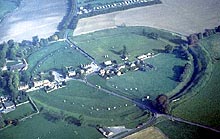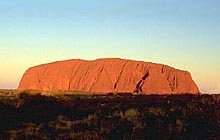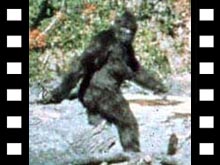|
|


Editorial
|
Fragments
|
Shasta I
|
Sea Serpents I
|
Atlantis I
Register
for our new Hall of Records Newsletter!
Questions? Comments? Suggestions? Advertising? Press Releases?
Contact us!
Avebury
|
Ayers Rock
|
Bigfoot
|
Oracle of Delphi
|
Books


An aerial view of the Avebury stone circle complex, in southwest England. With over 150 stones and and outer circle over a mile
in circumference, Avebury is the largest known neolithic religious complex in the world.
|
|
Avebury is an ancient religious center located in southwest England, just 24 miles north of its more famous cousin,
Stonehenge.
Avebury, however, is actually much larger than Stonehenge and, it is believed, played a more important role in England's
prehistory. Avebury was built around 2400 b.c., during the Neolithic Period, and was in regular use for over 2,300 years.
The primary stone circle is the largest in the world, being over 1,400 feet in diameter, surrounded by a deep trench over a mile
in circumference. The trench was carved out of solid rock with only primitive tools, and was believed to have once been
filled with water, making the inner stone circle sit on what appeared to be an island. Unfortunately, most of the stones have
been removed and reused to build the village of Avebury, part of which actually resides within the circle.
The primary stone circle also contains two inner circles, each over 300 feet in diameter, identified as the "Northern Inner Circle"
and the "Southern Inner Circle" respectively. The Northern Inner Circle contains a set of three sarsen stones called "The Cove"
which, it is believed, identifies that circle as representing femininity. The Southern Inner Circle once contained an obelisk,
which was believed to identify that circle as representing masculinity. Though there is no direct evidence, it is probable that
the inner circles were used in fertility rituals by the ancient Britons to enhance the fertility of the land, as that sort of
belief was common throughout the ancient world.
The primary stone circle also has four gaps roughly corresponding to north, south, east, and west. From the southern and western
gaps are two double rows of standing stone "roads" 50 feet in width and around 1-1/2 miles in length. The southern road,
colloquially referred to as "West Kennet Avenue" terminates at a now demolished stone circle commonly referred to as "The Sanctuary".
The western road, the existence of which is theoretical, was believed to have originally extended about a mile to the west, making
the entire complex appear to be formed in the shape of a sinuous serpent with a large bulge in the middle (the primary stone circle),
as if it had swallowed an egg. This theory is supported by the fact that a ancient American mound complex in North America, the
Serpent Mound in Ohio,
is also formed in the shape of a serpent swallowing an egg.
Avebury
is located in southwest England, just east of Bath, and close to Silbury hill, the largest man-made mound in Europe.
The stones are open to the public year round, but the Alexander Keiller
Museum and Barn, containing numerous artifacts and a multimedia presentation giving a detailed history of the area, is
open only during the day. For more information, check out the following links.



 The National Trust: Avebury
The National Trust: Avebury
 Visit Wiltshire: Avebury
Visit Wiltshire: Avebury
 Earth Mysteries: Avebury
Earth Mysteries: Avebury
 Avebury: Stone Circles and Henge
Avebury: Stone Circles and Henge
 SacredSites.com: Avebury
SacredSites.com: Avebury
 Avebury Stone Circle Panoramic Tour
Avebury Stone Circle Panoramic Tour
 Avebury Stone Pictures
Avebury Stone Pictures
 Stones of England: Avebury
Stones of England: Avebury
 Avebury: General Info
Avebury: General Info
 The Wiltshire Web: Avebury
The Wiltshire Web: Avebury
 Megalithia: Avebury
Megalithia: Avebury
|
|
|


Ayers Rock, or "Uluru", as it was originally named by Australia's aboriginal inhabitants. A massive sandstone rock, stained
red by iron deposits, most of Ayers Rock actually lies deep beneath the surface of the plain.
|
|
Ayers Rock is a massive, majestic sandstone outcropping embedded deep in the heart of Australia's Northern Territory. It's
iron-stained surface
changes color
by the hour as the sun passes from rising to setting, shifting from brilliant orange to blood red,
and even to a deep violet in the evening. Ayers Rock is one of Australia's most popular tourist attractions, and in many ways
defines both the physical and cultural landscape of Australia's rugged Outback.
Ayers Rock is a little over 1,000 feet high, two miles long, and one mile wide, forming a rough oval. It was originally discovered
by the European explorer William Gosse in 1873, who named it Ayers Rock after Sir Henry Ayers, Australia's premier at the time.
To the aborigines, however, the native inhabitants of Australia, Ayers Rock was known as "Uluru". Because of this, the name of
the park surrounding Ayers Rock was changed in 1995 to Uluru-Kata Tjuta National Park, in honor of the Anangu tribe of aborigines
who had inhabited the land for over 20,000 years, and who revered Uluru as a central part of their religious and ethnic identity.
More important than being a mere tourist attraction, Uluru also stands at the center of the Anangu's mythology.
The Anangu believe Uluru was formed during the Tjukurpa , or "Dreamtime", a period in earth's formative period when
giants walked the land, creating the natural features that now characterize Australia. This was particularly true of Uluru,
which the Anangu believe displays on its many rugged features reminders of the wars and struggles of the giants of the Dreamtime.
These giants, which were part human, part animal or plant, went on journeys and quests, making trails, hunting, fishing, building
fires, finding waterholes, and generally setting the pattern of living for their human descendants to follow, which the
Anangu follow to this day. This information was passed down in the form of songs and ritual ceremonies, and their entire world
is based upon the mysteries, magic, and myths that they believe were passed down to them from the giants of the Dreamtime.
Ayers Rock has been classified as a
World Heritage site,
making it one of the most important historical landmarks on earth.
Uluru is located in the Uluru-Kata Tjuta National Park a little over 200 miles southwest of Alice Springs in Northern Territory,
Australia. Much of the park is inaccessible, due to the fact that it contains many sites that are sacred to the Anangu, but
several trails
are open that provide spectacular views of Uluru as well as guided tours of the many interesting features to be found on
and around its rough slopes.



 Destinations - Uluru
Destinations - Uluru
 Sahara Outback Tours
Sahara Outback Tours
 Travelabout: Perth Western Australia
Travelabout: Perth Western Australia
 Big Country Outback Safaris
Big Country Outback Safaris
 Desert Tracks: Pitjantjatjara Tours
Desert Tracks: Pitjantjatjara Tours
 Ayers Rock, Uluru
Ayers Rock, Uluru
 Uluru (Ayers Rock)
Uluru (Ayers Rock)
 TravelAddicts: Uluru
TravelAddicts: Uluru
 Australia Culture and Recreation: Uluru
Australia Culture and Recreation: Uluru
 Northern Territory Visitor's Bureau
Northern Territory Visitor's Bureau
 Northern Territory Visitor's Centre
Northern Territory Visitor's Centre
|
|

|


The classic Bigfoot image from the famous "Patterson Film", taken in 1968. This film is the best bit of evidence thus far
supporting the evidence of Bigfoot. Adapted from
Patterson/Gimlin,
©1968 René Dahinden. All Rights Reserved.
|
|
The classic image of Bigfoot is of an 8-foot tall, shambling apelike creature that haunts the deepest wilderness areas of
the world. Called "Sasquatch" by the native Americans, "Yeti" in Asia, "Orang Pendek" in Malaysia, and the "Skunk Ape" in
America's Deep South, these ancient hominids have been spotted in some form in most parts of the world. Yet, despite its
ubiquitousness, no intact skeletal remains — or any other definitive proof of the existence of Bigfoot —
has ever been found.
Certainly a great deal of evidence has been brought forward to prove the existence of this elusive, apelike creature:
hair samples, spoor, bone fragments, recordings of its chilling howl, and of course the classic Bigfoot footprint. However, no
definitive proof has ever been offered, as all of these bits of evidence by themselves do not carry enough weight for
the scientific community to treat as anything more than curiosities. So, until a complete specimen, or enough of a complete
specimen, can be presented to the scientific community for testing, Bigfoot will remain a wonderful bit of folklore around
which humanity will continue to build a rich tradition of myth and legend.
For those interested in capturing a glimpse of these elusive creatures, their favorite haunts appear to be the vast woodlands
of America's Pacific Northwest, including Northern California (particularly the
Mount Shasta
area, also covered in this issue), Florida's Everglades, the Himalayan Mountains in Tibet, the Rain Forests of Malaysia and,
some say, as close to home as Ohio. Sightings have also been reported
all over the United States,
so you may not have to travel far. Look for a four-part series on Bigfoot and his brethren starting next spring, in which
we will discuss this mystery in detail.



 Bigfoot Field Researcher's Organization
Bigfoot Field Researcher's Organization
 Bigfoot: Fact or Fantasy?
Bigfoot: Fact or Fantasy?
 Bigfoot Encounters
Bigfoot Encounters
 Sasquatch Information Society
Sasquatch Information Society
 The Bigfoot Times
The Bigfoot Times
 The Bigfoot Museum
The Bigfoot Museum
 The Cryptozoo Archives: Hairy Hominids
The Cryptozoo Archives: Hairy Hominids
 Ohio Bigfoot Research and Study Group
Ohio Bigfoot Research and Study Group
 Bigfoot Forums
Bigfoot Forums
|
|
|


An artistic representation of the Delphic Oracle. The oracles were delivered by a priestess of Apollo, the Pythia,
who sat on a tripod like this one over a chasm in the earth from which volcanic gasses flowed. Her utterances were then
interpreted by a priest. Image copyright � 1996, Philosophical Research Society. All Rights Reserved.
The Oracle of Delphi was an ancient religious center in Greece, known throughout the ancient world for the prophesies of
the Pythia, the priestess of Apollo who uttered the oracles that gave Delphi its fame. The history of the Oracle
actually stretches well into the second millennium b.c., when it was a major center of worship for
Poseidon and Gaia, gods of the Myceneans. In their myths, the cave in which the oracles were
uttered was said to be guarded by Gaia's son Python, who took the form of a giant snake. Thus the priestess came to be
known as the "Pythia", and the region around the oracle came to be known as "Pytho".
Around the 8th century b.c., however, the Myceneans were conquered by the Greeks, who brought
with them the worship of the god Apollo. As a result, some believe, the myths surrounding the oracle were changed,
where Apollo was now seen as having defeated Poseidon and Gaia, and having taken control of the oracle for himself.
The name "Delphi" was then given to the oracle, as it was believed that Apollo had appeared to a group of sailors
in the form of a dolphin, leading them to the oracle and ordaining them as his priesthood.
The priestess retained the title of "Pythia", however, probably out of respect for the deities that Apollo had supplanted.
In order to commune with Apollo and deliver the oracles, the Pythia would sit
on a tripod situated within a cave, set over a fissure in the floor of the cave from which issued volcanic gasses. The
gasses would have a narcotic effect on the Pythia, who then fell into a "trance" and saw visions, making incoherent,
usually arcane statements, which were then interpreted by a priest for those who had paid for the oracle's services.



For more information on visiting the Oracle, please consult the following links:
 The Oracle of Delphi
The Oracle of Delphi
 The Delphic Oracle
The Delphic Oracle
 Ancient Oracles: Oracle at Delphi
Ancient Oracles: Oracle at Delphi
 Nature.com: Oracle's Secret Fault Found
Nature.com: Oracle's Secret Fault Found
 Greek National Tourism Organization
Greek National Tourism Organization
 GNTO: Tourism Information Offices
GNTO: Tourism Information Offices
 GNTO: Licensed Tour Guides
GNTO: Licensed Tour Guides
|
|
Avebury
|
Ayers Rock
|
Bigfoot
|
Oracle of Delphi
|
Books
Editorial
|
Fragments
|
Shasta I
|
Sea Serpents I
|
Atlantis I
Register
for our new Hall of Records Newsletter!
Questions? Comments? Suggestions? Advertising? Press Releases?
Contact us!



 The Great Stone Circles of Britain, Ireland, and Brittany
The Great Stone Circles of Britain, Ireland, and Brittany
Aubrey Burl
This is the long awaited and substantially revised edition of Burl's first and highly acclaimed book for Yale,
The Stone Circles of the British Isles,( 1976 cloth sales 8400, pb 1979 30* sales 10,000.) It comprises a complete and
detailed overview of the prehistoric stone circles of Britain and Ireland and also, for the first time, their French
counterparts, the cromlechs of Brittany. Taking into account the crucial research and discoveries which have taken
place over the last twenty years, Burl reassesses amongst others the haunting circle at Callanish in Scotland as well
as the world-famous Stonehenge, calling into question its dates, phases, astronomy, builders and above all its purpose.
(Review by Amazon.com)
Click
here
to buy this book.
 The Secrets of the Avebury Stones: Britain's Greatest Megalithic Temple
The Secrets of the Avebury Stones: Britain's Greatest Megalithic Temple
Terence Meaden
Avebury, less than 20 miles from its more famous neighbor, Stonehenge, is rich in symbols linked to pre-Christian
Goddess religions. This book reveals the wonders of the site, the largest and most complex prehistoric monument
in Britain, through a lavishly illustrated guided tour encompassing history, archaeology, spirituality, and art.
(Review by Amazon.com)
Click
here
to buy this book.
 Lonely Planet Australia (Australia, 11th Ed)
Lonely Planet Australia (Australia, 11th Ed)
Paul Harding
Whether you want to walk the Larapinta Trail or dive on Ningaloo, wine and dine in multicultural Melbourne or gaze at the stars in the
awesome Outback - you'll find this guide to the continent of extremes indispensable.
Features: 158 maps, including Olympic sites & Outback tracks; full colour features on Aboriginal art, native animals and plants;
comprehensive entertainment information, form pubs to opera; hundreds of accommodation options, from bush camping to five star hotels;
and Olympic Games section detailing free events & history.
(Review by Amazon.com)
Click
here
to buy this book.
 The Field Guide to Bigfoot, Yeti and Other Mystery Primates Worldwide
The Field Guide to Bigfoot, Yeti and Other Mystery Primates Worldwide
Loren Coleman, Patrick Huyghe
Thousands of reports of a wide variety of mysterious primates have intrigued humans since the beginning of recorded history,
yet these shy and reclusive beings have eluded the most diligent attempts to verify their existence. Here is the first-ever
comprehensive study on an astonishing variety of puzzling apelike and humanlike animals that are still being seen today.
This fully referenced volume includes range maps and typical footprints for each type of undiscovered creature sighted
around the world, as well as:Actual eyewitness accounts of sightingsDetailed IllustrationsNewest findings in an exciting
branch of cryptozoologyLikeliest locales and most common subtypes for sightingAdvice on what to do if a sighting occurs.
And much more!
(Review by Amazon.com)
Click
here
to buy this book.
 Mysterious America: The Revised Edition
Mysterious America: The Revised Edition
Loren Coleman
Loren Coleman's highly-praised, 1983 classic work, Mysterious America, has been thoroughly updated for this revised edition.
This new edition contains an invaluable, never-before-published index; two completely new chapters, "Giant Catfish" and
"Minnesota Iceman"; a new list, "The American Lion," with 141 entries; several extensively rewritten chapters,
"A Case Study: The Dover Demon," "The Teleporting Animals and Magnolia," "The Phantom Panthers," "Maned Mystery Cats,"
"Mystery Kangaroos and Devil Monkeys," "Eastern Bigfoot: Momo and Marked Hominids"; and new material and updates to several
chapters, "Devil Names and Fortean Places," "Alligators in the Sewers," "Giant Snakes," "Lake Monsters," "Champ,"
"The Jersey Devil," "The Phantom Clown."
(Review by Amazon.com)
Click
here
to buy this book.
 Lonely Planet Greece (Greece, 5th Ed)
Lonely Planet Greece (Greece, 5th Ed)
David Willett, Carolyn Bain, Brigitte Barta, Kate Daly, Rose Hall
From Antarctica to Zimbabwe, if you're going there, chances are Lonely Planet has been there first. With a pithy and matter-of-fact
writing style, these guides are guaranteed to calm the nerves of first-time world travelers, while still listing off-the-beaten-path
finds sure to thrill even the most jaded globetrotters. Lonely Planet has been perfecting its guidebooks for nearly 30 years and as
a result, has the experience and know-how similar to an older sibling's "been there" advice. The original backpacker's bible, the LP
series has recently widened its reach. While still giving insights for the low-budget traveler, the books now list a wide range of
accommodations and itineraries for those with less time than money.
Lonely Planet's Greece is an expert guide to this incredible country, covering everything from the narrowest walkable gorge in the
world to classic Greek myths. The authors provide information on inter-island ferries accompanied by a ferry map; extensive writings
on history, culture, and mythology; place names in Greek script; and advice on choosing a quiet or gregarious island vacation.
A special color feature covers Greek art.
(Review by Amazon.com)
Click
here
to buy this book.
Editorial
|
Fragments
|
Shasta I
|
Sea Serpents I
|
Atlantis I
Register
for our new Hall of Records Newsletter!
Questions? Comments? Suggestions? Advertising? Press Releases?
Contact us!
|
|
















 The Great Stone Circles of Britain, Ireland, and Brittany
The Great Stone Circles of Britain, Ireland, and Brittany The Secrets of the Avebury Stones: Britain's Greatest Megalithic Temple
The Secrets of the Avebury Stones: Britain's Greatest Megalithic Temple Lonely Planet Australia (Australia, 11th Ed)
Lonely Planet Australia (Australia, 11th Ed) The Field Guide to Bigfoot, Yeti and Other Mystery Primates Worldwide
The Field Guide to Bigfoot, Yeti and Other Mystery Primates Worldwide Mysterious America: The Revised Edition
Mysterious America: The Revised Edition Lonely Planet Greece (Greece, 5th Ed)
Lonely Planet Greece (Greece, 5th Ed)